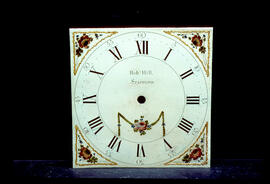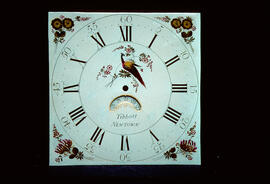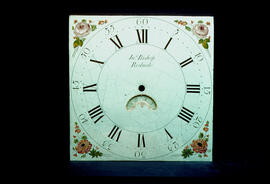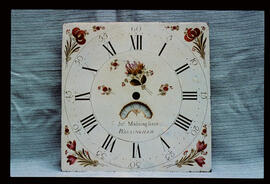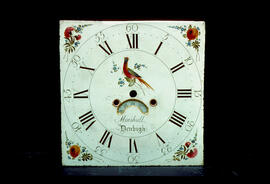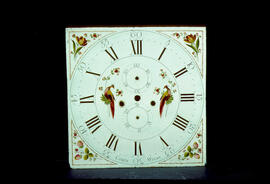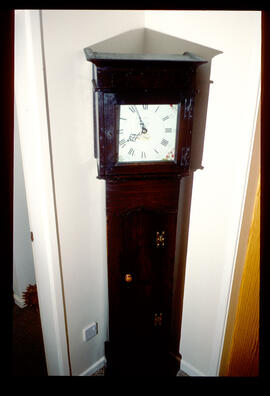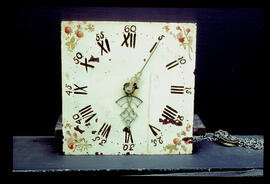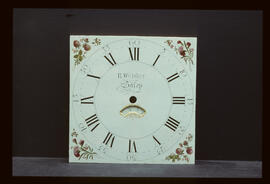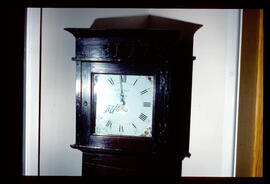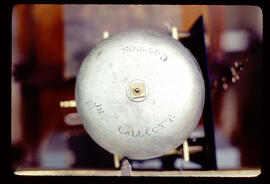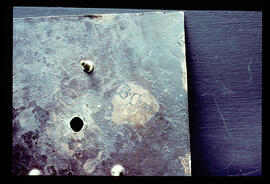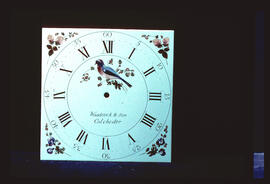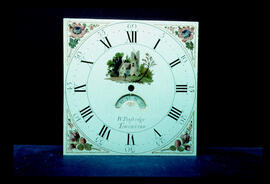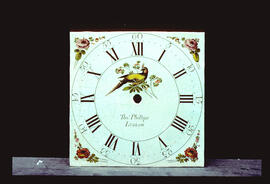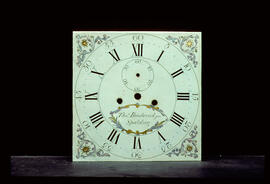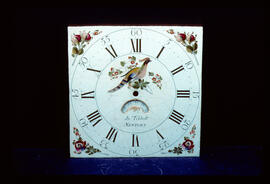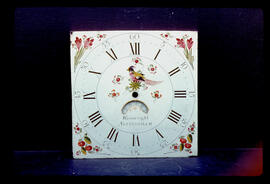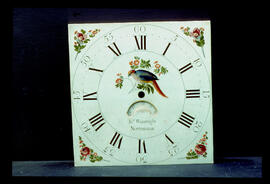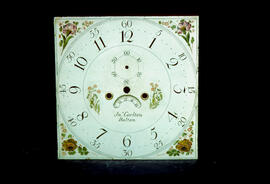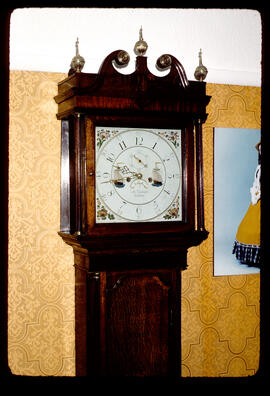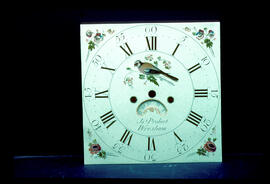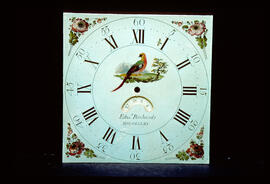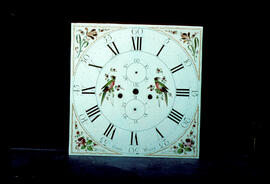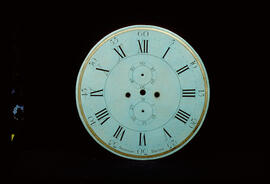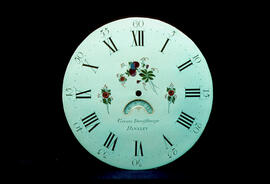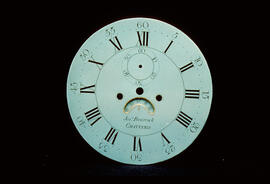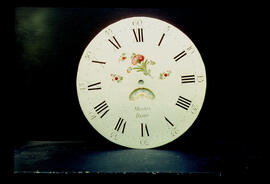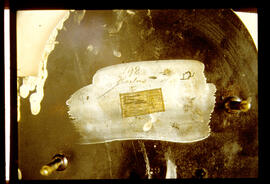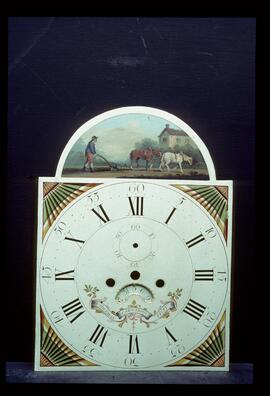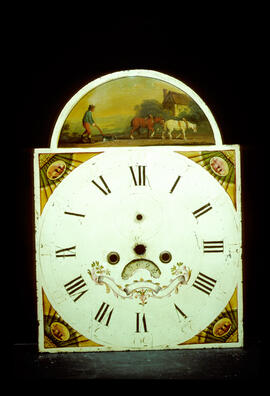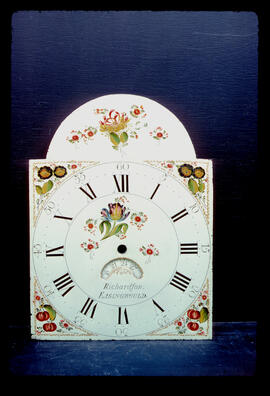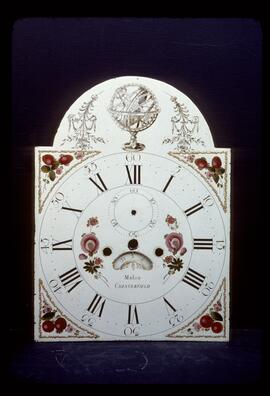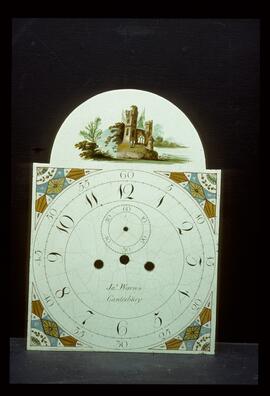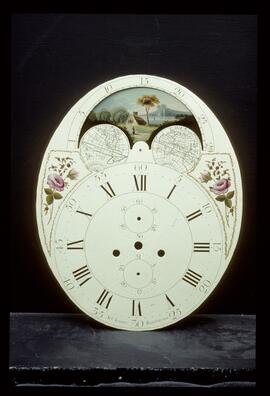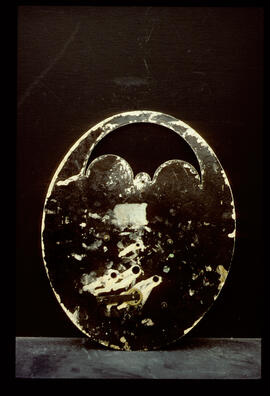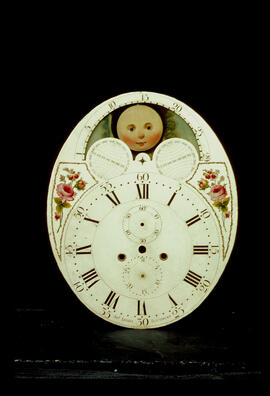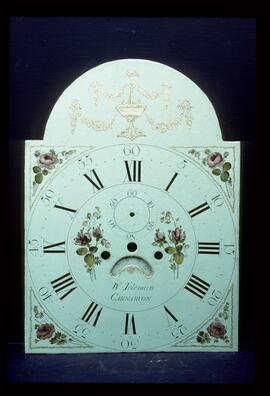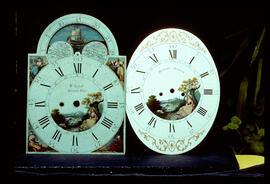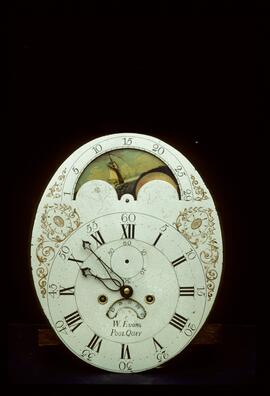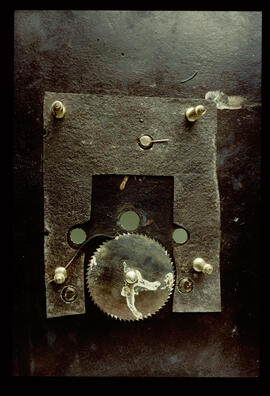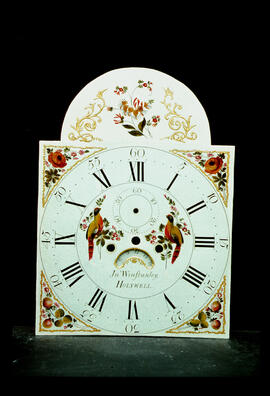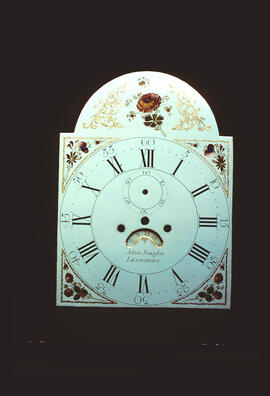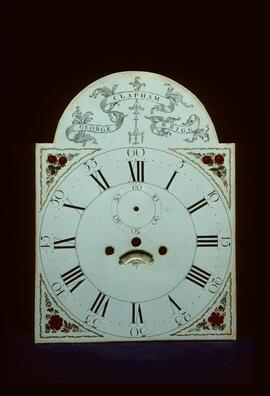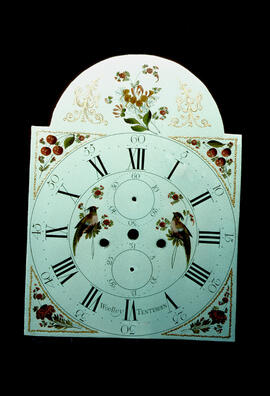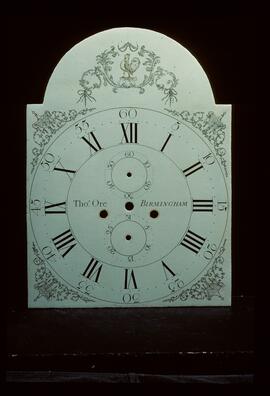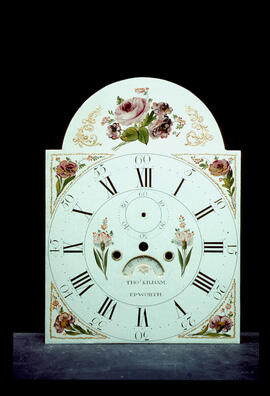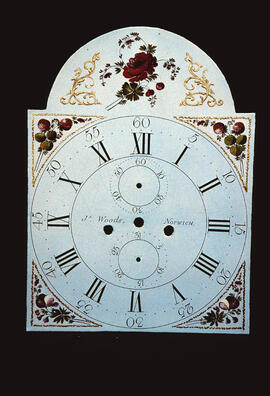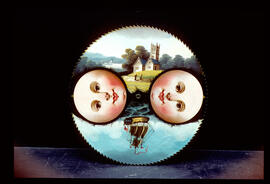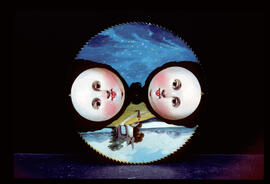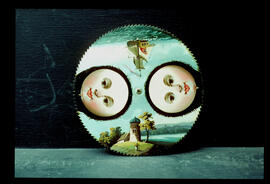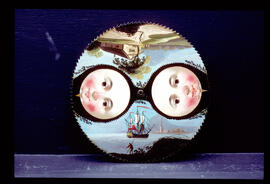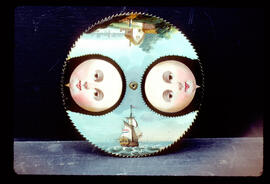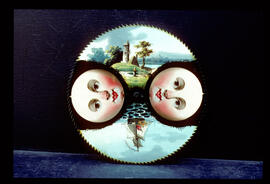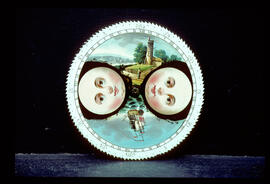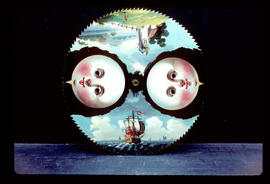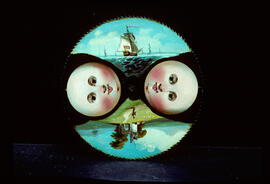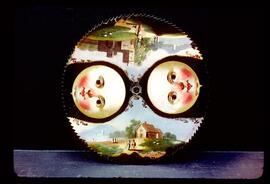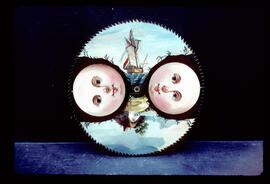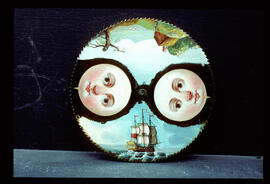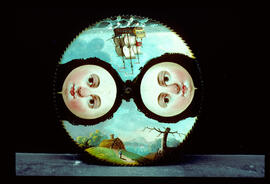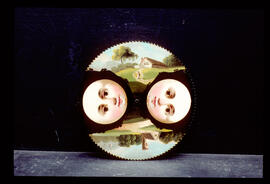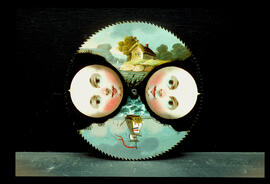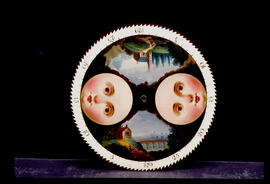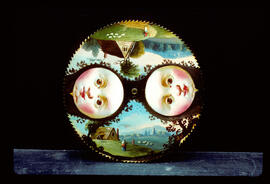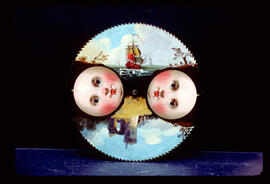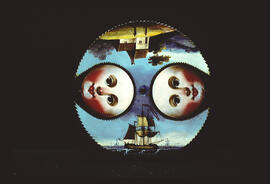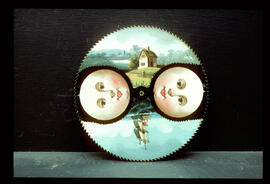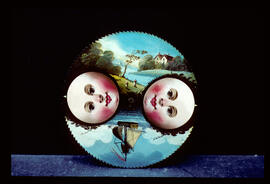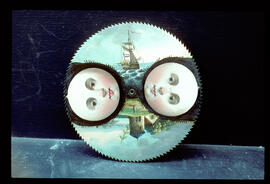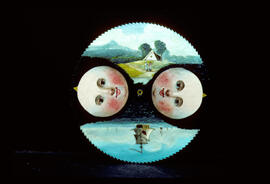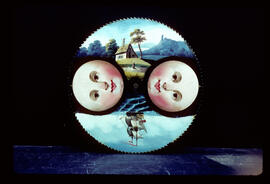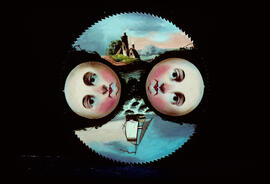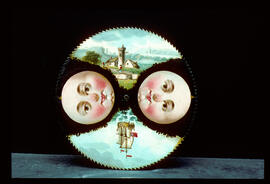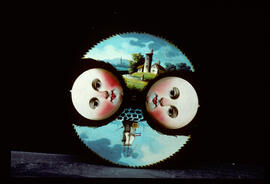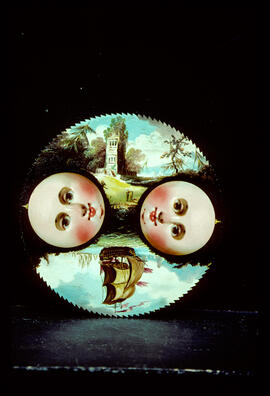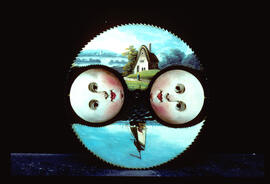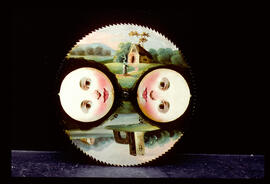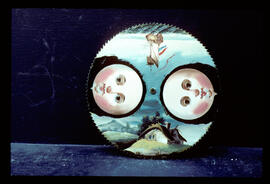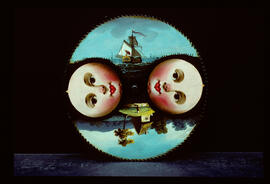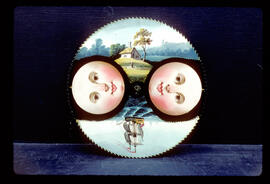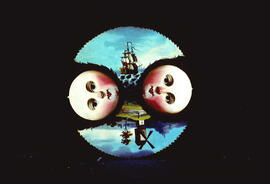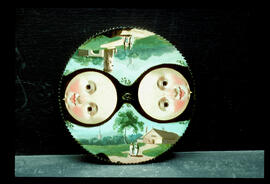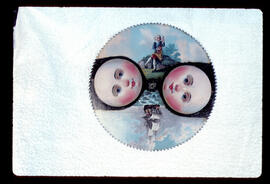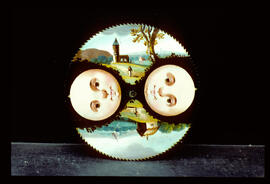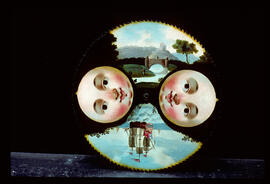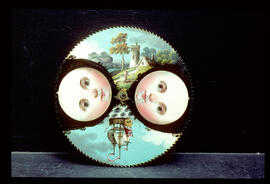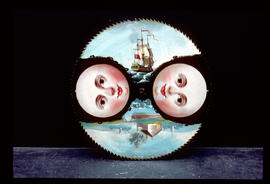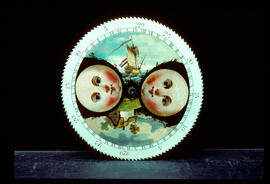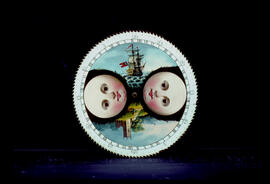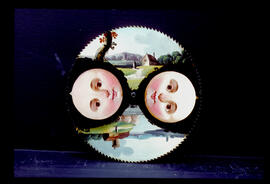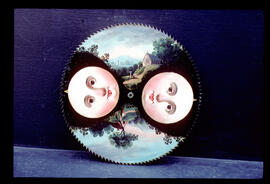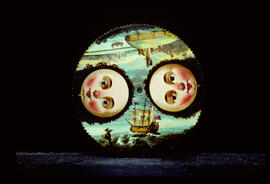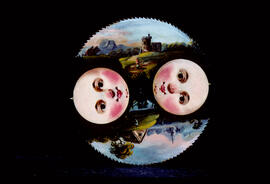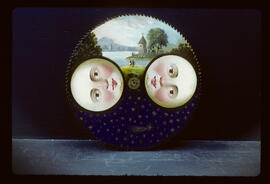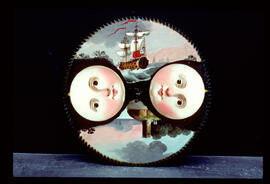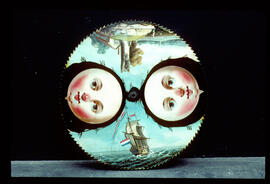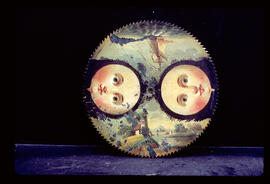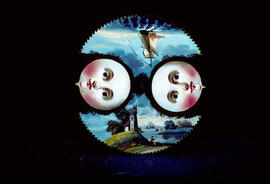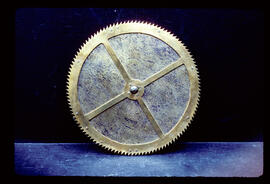Main dial: blue-grey; anemone all corners; gesso-framed unusual garland with blue-petalled rose lower centre.
Main dial: blue-grey; early type bird, honeysuckle and auricula corners.
Main dial: blue-grey; roses and ranunculus or anemones corners; no gesso.
Main dial: blue-grey; lilies and crocus corners; honeysuckle centre.
Main dial: blue-grey; one Osborne-type long-necked bird in centre; roses and carnations in corners, no gesso.
Main dial: blue-grey; two Osborne-type long-necked birds in centre; tulips and strawberry corners with gesso framing. False plate: cast iron.
Main dial: dianthus and strawberries.
Main dial: dianthus and strawberries.
Main dial: dianthus and strawberries.
Main dial: dianthus and strawberries.
Main dial: carnations and yellow ranunculus corners; line-framed gold band around chapter ring; two ships in centre. False plate: double Wilson CI.
Main dial: repaint, fat bird no gesso, no date or seconds, "W" on back, strawberries and vetch corners.
Main dial: decorated centre.
Main dial: name in cartouche; grey acanthus gold star corners. "K" on back. Nice dial, thin plate.
Main dial: floral corners; medium bird centre.
Main dial: floral corners; medium bird centre.
Main dial: fat birds.
Main dial: flowers in centre, unrestored.
Main dial: carnations and yellow ranunculus corners; line-framed gold band around chapter ring; two ships in centre. False plate: double Wilson CI.
Main dial: fat birds.
Main dial: fly dial no damage; medium long-tailed bird centre with scenery; anemone corners, no gesso.
Main dial: tulips and fat roses gesso-framed corners; two medium long-tailed birds centre.
Main dial: creamy, no décor, just gold band, dot minutes. False plate: cast iron.
Main dial: blue-grey; vetch in centre.
No décor. Small "B" on back in splodge.
Main dial: blue-grey; well-painted carnation dial centre.
Main dial: reverse of clock dial with label "198 Harlow".
Main dial: fan corners, green, some yellow and orange; tandem plough man in breakarch, decorated ribbon for name.
Main dial: curved-in ribbon with decorations; off-white; dirty man with plough in breakarch, same as 1469; vignette in fan corners. Unrestored record only.
Main dial: primulas and cherries gesso-framed corners; tulip in centre; honeysuckle in breakarch.
Main dial: strawberry and cherry framed corners; round vetches centre; armillary sphere with garlands in breakarch, all transfer print.
Main dial: geometric corners, small rudimentary fans, gold diamond, pale blue and yellow ochre; free-standing ruin in breakarch.
Main dial: cream rose and bird in corners. Hemispheres: maps, correct for size and period. False plate: cast iron.
Main dial: off-white; turned cream rose and bird in corners; had been repainted over twenty years ago. Hemispheres: maps, correct for period.
Main dial: off-white; turned cream rose and bird in corners; had been repainted over twenty years ago. Hemispheres: maps, correct for period.
Main dial: pink roses and peonies gesso-framed corners; moss roses centre; urn with garlands all gesso breakarch. False plate: cast iron.
Two dials, Wilson on the right. Main dial: complete repaint.
Main dial: blue-grey; complicated gesso above centre; corners maps gone; moon age in breakarch.
Main dial: gesso corners, early style; large rose in breakarch, gesso flowers and scrolls. False plate: handmade.
Main dial: strawberries and orange red roses corners; fat birds centre; honeysuckle breakarch with gilded gesso (we added breakarch to fit case). False plate: cast iron.
Main dial: vetch and strawberry gesso-framed corners; ranunculus in breakarch with gesso and scrolling; nice dial. False plate: cast iron.
Main dial: strawberries and single anemones, fine gesso framing; blue small flowers in corners, elaborate transfer. False plate: cast iron.
Main dial: cherries and black-eyed susan gesso-framed corners; two fat birds centre; honeysuckle in breakarch with rather heavy gesso. False plate: cast iron.
Main dial: transfer print corners; urn breakarch, cockerel with acanthus leaves and bow knots.
Main dial: large carnations corners; very large rose breakarch; open cracking. False plate: cast iron.
Moon faces: round-eyed, sweet expression.
Moon faces: round-eyed, sweet expression. Moon scenes: starry sky with suggestions of clouds; very unusual at this period.
Moon faces: usual Wilson, with slightly dreamy expression. Moon scenes: ship at sea; small house with tower and lake or river.
Moon faces: round-eyed, rather sweet and pensive. Moon scenes: ship at sea; landscape with house and tree.
Moon faces: sweet-faced and pensive. Moon scenes: ship at sea; landscape with cottage with lake in distance.
Moon faces: round-eyed. Moon scenes: ship at sea; tower with hut and tree.
Moon faces: pleasant. Moon scenes: ship at sea; small building, large tower.
Moon faces: small features, round eyes, pensive. Moon scenes: ship at sea; landscape with tower by waterside.
Moon faces: round-eyed. Moon scenes: two landscapes, both with water.
Moon faces: round-eyed, small mouth. Moon scenes: ship at sea; cottage in landscape.
Moon faces: round-eyed, quite pleasant. Moon scenes: ships at sea; cottage and dead tree.
Moon faces: round-eyed, a bit ugly, rather serious. Moon scenes: ship at sea; landscape with cottage and dead tree.
Moon faces: round-eyed, pensive. Moon scenes: two land scenes cottage; building with tower.
Moon faces: Round-eyed, pink nose. Moon scenes: cottage by lakeside; ship at sea.
Moon faces: round-eyed, sweet faces rather pensive. Moon scenes: aqueduct, with moon's age round outside of dial.
Moon faces: round-eyed, serious. Moon scenes: two cottages with landscapes, well painted.
Moon faces: round-eyed, a bit staring. Moon scenes: ship at sea; ruined abbey.
Moon faces: pleasant. Moon scenes: ship at sea, very nice and detailed; church and view, nice moon detail.
Moon faces: sweet expression. Moon scenes: cottage with distant view including lake; ship and regular waves.
Moon faces: pursed lips. Moon scenes: mid-sized ship; lakeside scene with person.
Moon faces: serious. Moon scenes: ship at sea; small house with tower and blue roof.
Moon faces: serious. Moon scenes: ships at sea; cottage with painted roof, two people; very poor condition, lots of inpainting.
Moon faces: sweet expression. Moon scenes: ship at sea; landscape with cottage and tree.
Moon faces: a bit serious. Moon scenes: small ship; funny cottage on lake/streamside.
Moon faces: self-satisfied, round-eyed. Moon scenes: cottage with tower; ship at sea; crude painting.
Moon faces: sweet, pink cheeks. Moon scenes: house with tower; ship at sea, stiff waves.
Moon faces: usual pleasant Wilson. Moon scenes: ruined tower; ship at sea.
Moon faces: pensive. Moon scenes: small ship at sea; cottage with lake in background.
Moon faces: rather dreamy. Moon scenes: abbey; cottage with figure.
Moon faces: round-eyed, pensive, pink rose. Moon scenes: small ship at sea; cottage on hill, view in distance.
Moon faces: round-eyed. Moon scenes: ship; cottage with tree.
Moon faces: round-eyed, slight smile. Moon scenes: ship at sea, cottage with tree.
Moon faces: round-eyed, serious.
Moon faces: pleasant, quite pink cheeks. Moon scenes: two figures with house; two figures with tower.
Moon faces: round-eyed, rather pensive. Moon scenes: ship scene; violin player on rock.
Moon faces: rather serious and pale. Moon scenes: scene with tower; scene with house and figure.
Moon faces: surprised expression. Moon scenes: ship at sea; bridge over lake and tree.
Moon faces: pensive. Moon scenes: ship at sea; building with tower, leaning tree and standing figure; well painted.
Moon faces: round-eyed, smiling. Moon scenes: ship at sea; cottage by river with bridge.
Moon faces: round-eyed, smallish mouth. Moon scenes: ship at sea with huge flag; cottage in landscape with tree.
Moon faces: round-eyed, sweet face. Moon scenes: ship at sea; church in landscape.
Moon faces: round-eyed. Moon scenes: two land scenes, both with some water.
Moon faces: slightly pensive, small mouth. Moon scenes: cottage with pink skies; landscape with cottage and pink skies.
Moon faces: pursed lips. Moon scenes: ship at sea; lake scene with boat, three men, old mill on promontory.
Moon faces: quite pleasant, large features. Moon scenes: ruined castle and figure; cottage by water's edge, church in distance.
Moon faces: rather serious. Moon scenes: mid-blue sky with comet, lakeside scene, well painted.
Moon faces: sweet and rather pensive. Moon scenes: very unusual ship with men on yardarm; lakeside scene with rather pink sky.
Moon faces: pleasant, pensive, Wilson faces. Moon scenes: ship at sea; cottage with tower.
Moon faces: round-eyed. Moon scenes: ship at sea; landscape with ruined tower and man fishing.
Moon faces: round-eyed. Moon scenes: ship at sea; landscape with ruined tower and man fishing.
Main dial: roses and ranunculus gesso-framed corners; burnt dial, small. Hemispheres: North America, ecliptic below equator. False plate: cast iron.
